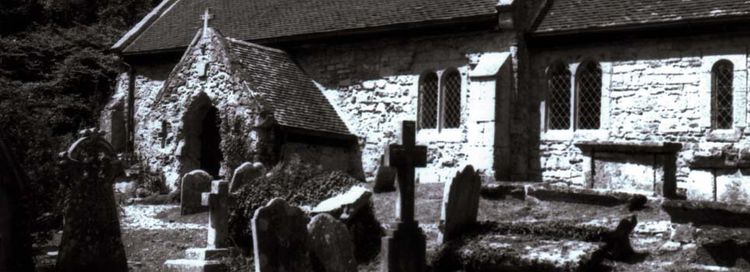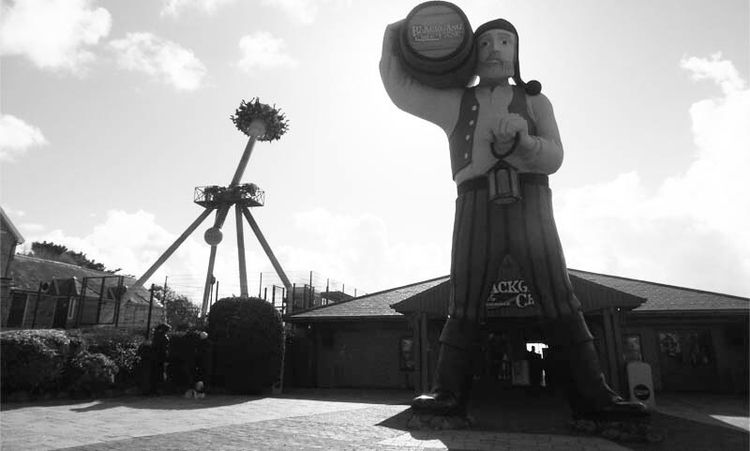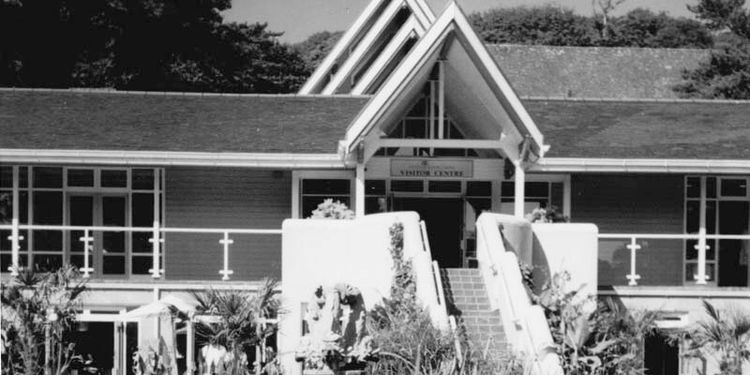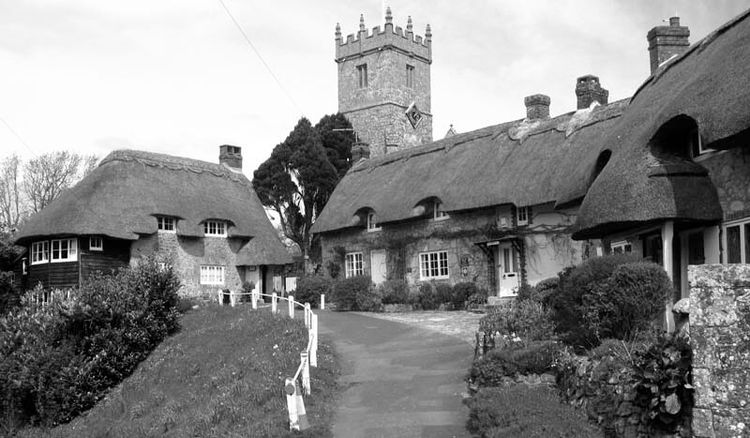Brading's 'Druid Well'. Ghosts of the Isle of Wight, with Margo Williams

Brading's Aristocratic Ghost
A ghost appears in the Old Rectory Mansion building in Brading. Those who have seen it describe an 'aristocratic' figure gliding disdainfully through walls. Some ghost hunters suggest it is the frustrated spirit of Sir Bevis Thelwell, the man who first drained Brading Haven and achieved his own ruination; searching for the wretched leak.
Summer 1609, granted permission by King James, Sir Bevis struck a deal with Sir Hugh Myddleton to employ a small army of Dutch groundsworkers to construct a sea defence and drain the Haven. For a while that defence held, and the workers were paid. The huge muddy project cost £6,000; a lot in those days.
Alas a storm struck the island, the wall sprang a leak and Sir Bevis was ruined.
For all that money and trouble all Bevis and the Brading residents found was ground too salted for planting, and a stone well. "Roman," guessed the local historians. "Druid," said the mystics of Brading.
No one has ever reported seeing a ghostly Druid in Brading; or any place else on the island, as a matter of fact. Why not is a good mystery.
The Druids of Coranied
Brading, so Victorian mythweavers insisted was the Isle of Wight Druids' sacred site, rivalled only by the Pillars of Ur, the great Needles Rocks at the far end of the chalk spine traversing the island now known as the Needles.
Abraham Elder in Tales & Legends of the Isle of Wight described the evening scene of Brading's dim and very distant past: the annual Druid party at Brading Well. A feast of Druid delicacies, mistletoe and interesting pyrotechnics as the main event.
"The Druids of the Coranied held a day of sacred mysteries on the sixth day of the moon, in that month of the year when the nights are longest; for they venerate the night rather than the day.
Because darkness was more ancient than light, and because the lot of their race was cast toward the setting sun.
House of Wax
Even to this day folklorists remind us with gory glee of the Druids' grim religious reputation. Of how once a year they assembled in Brading to watch a gruesome spectacle. This is the horrific image people hold about Druids.
Most of us assume when Druidism ended, so did the nasty annual parties.
No. Things got worse. Now gone, for many years the Old Rectory Mansion housed a popular wax-works exhibition. In its basement the Chamber of Horrors zone displayed a wide and terrifying range of devices used by people on people, long after the Druids were history.
Exploring the haunted Isle of Wight

Prepping for the Big Event
Abraham Elder continued the story, of how on the morning of the sixth day, the Arch druid led a procession to cut the mistletoe from the oak. Elder described the event with his own eyes.
They stood in a large circle round the tree and two Owids held a ladder against it. The Arch-druid then, in his white robes of ceremony, ascended the oak tree, armed with a golden knife, and he touched the mistletoe with the knife, whilst the other Druids caught it below in a broad white cloth.
Abraham Elder added that if the mistletoe touched the ground, or not caught in a white cloth, it lost its virtue. Any Druid knew that.
We don't really know that. Maybe it's true, maybe it isn't. No written Druidic information exists - a holy book - to tell us of their beliefs. All we have are observations by contemporaries including Roman soldiers who fought the Celts.
The Celts' fierce heroism was attributed to the teachings of Druids about how the soul was immortal; sure death might sting but it was only temporary, and they would see them after. So certain were they of this, warrior and Druid both when facing certain death gave and accepted I.O.U.s to be repaid in the hereafter.
The Druids' opinion on matters of life and death differed to those priests who officiated at public events later in history, and yet shared so many similarities.

Caesar On What Druids Did
Probably the best insight into who and what were the Druids comes from the Roman general Julius Caesar: in De Bello Gallico,
Druids, noted Caesar, “...are engaged in things sacred, conduct the public and the private sacrifices, and interpret all matters of religion."
Not just religion but education and justice. They functioned as police and judiciary. They elected an Archdruid and held synod-like assemblies. Training to become a Druid took as long as 20 years. Druids used the Greek alphabet to write; they taught philosophy, science and astronomy.
Caesar identified the source of their organisational Justice Department - the British Isles. Britain was the Head Office of European Druidism. They had a network of colleges, much like our present education system. For many centuries before the arrival of Christianity, these were the only organised system dedicated to education.
These colleges were both seminary and university. Twenty years of study graduated into a spiritual authority remarkably similar to those of present day western Church organisation. A priesthood that presided over sacred rites, oversaw justice and law; and elected an arch-Druid. Community punishments included shunning - the equivalent of Church practice of excommunication.
More similarity than difference.
The Difference Between Druidism and Later Religions
Except when it came to exiting this earthly existence. Priests of later times officiating at public events at places like Tower Hill and Tyburn in London offered a different experience. Their victims were coarsely shaved of hair, scraped raw then bound to a ready-to-light stake atop a pile of wood.
Or on a straw-strewn scaffold, a raised wooden platform soaked with fluids and gunge, the focus of attention of a huge jeering crowd there to witness suffering.
And suffering was delivered. Terrible things happened first. And while they still were conscious, the priest officiating at their extinction event informed them, loud enough so the crowd could hear, their next destination was Hell, where the real cruelty began.
No one knows how many 'heretic' Protestants, Catholics and Jewish peoples suffered over grievances and accusations regarding the correct worship of God. Thousands upon thousands of savage punishments were inflicted at huge public events; caused untold unimaginable suffering. This happened throughout Europe, for many centuries.
No one knows if Druids would have been impressed or appalled by the carnage. Druids spent twenty years studying philosophy and medicines; and probably offered their victims consolation by way of what happens next, and maybe a powerful consumable to ease their suffering.
What Happened to the Druids?
Druidism was outlawed during the Roman occupation of Britain. The Druids were not just religious leaders, but civil authorities too, and their multi-competent power could not be so well accommodated into the stratified Roman structure.
Druids had too much power: religious and secular; and the conquered Britons would always look to them for leadership, which in due course might lead to rebellion.
In the face of increasing discrimination Druids retreated to Anglesey in Wales where a large number were put out of business; though in Ireland and Scotland they continued. And became Christians.
Related link: Tintagel. On Merlin and What Happened to the Druids.
But that doesn't explain why no one ever reports seeing a Druid ghost; and equally intriguing - Roman or Saxon ghosts. One answer for that is time-limit. Ghosts eventually fade or find release; and the 'aristocratic' ghost of the Old Rectory Mansion is too recent.
Or, when the well gushed during the Druids' party, as storyteller Abraham Elder claimed, it kept on gushing until the land was lost below the water and the mystics washed away.
Thank you for your company on this short tour of Isle of Wight mysteries and haunting. If you would like to know more about Margo Williams' investigations in Brading's historic buildings and other matters of heaven and hell, read this book. Now available from Amazon.





